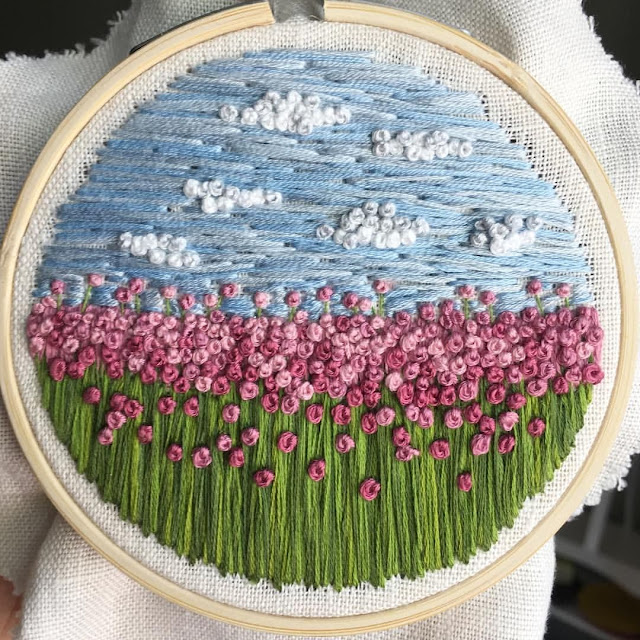The most beautiful instructions & pictures for embroidery
Embroidering pictures has been experiencing a triumphant comeback for several years and joining the popular ranks of DIY. The diverse possibilities of this old craftsmanship result in fantastic ideas that beautify the home. Here, you will learn the exciting history of embroidery and get great tips on embroidering pictures and creating and designing motifs. If you need to get well mastermind and beautified rooms get luxury apartments in Lahore.
Continuous development
and tradition of embroidery
Finds show that the
ancient Chinese, Indians, and Egyptians practiced embroidery. Geometric shapes
and representations of people and animals were embroidered and designed on
surfaces. The ancient Greeks and Romans adopted the art of embroidery and then
found its way into the monasteries in the Middle Ages. It was initially used to
decorate church vestments and altar clothing, so-called paraments lavishly.
Over time, embroidery became a secular craft, peaking in England and France in
the 14th century.
Gold embroidery, for
example, was booming in the Middle Ages, but it was done differently then than
it is today. Gold threads were sewn onto the background with overlay stitches
and then embroidered over them, allowing the gold to shimmer through. The
result was relief embroidery, which gave garments and wall hangings an
exquisite touch. Even today, a golden embroidery image is still trendy, with
the gold threads being embroidered directly.
Tip: Union Complex is the best spot for purchasing Union Apartments Lahore.
The application was
still laborious, and further developments followed. The device was only ready
for the market in 1850, thanks to the improvements made by the Rittmeyers and
their mechanic Franz Anton Vogler in St. Gallen. There was a real hype
surrounding the embroidery of pictures, which meant that exports from
Switzerland boomed and became one of the country's most important economic
sectors at the beginning of the 20th century. However, the Swiss soon had
competition from the Saxon Vogtland. Anton Falke from VOMAG in Plauen invented
the machine-embroidered tulle lace in 1881, which gained world fame as the 'Plauen
Lace' and is still exported to over 40 countries today.
Embroidery was and
will continue to be done by hand – although embroidery has often fluctuated in
popularity over the past 100 years, it has become a regular fixture in recent
years.
Designs and materials
for embroidery pictures
You can embroider
pictures or patterns on various surfaces. This is used, for example, to create
unique cushions or wonderful tapestry pictures that exude coziness thanks to
their textile character. Nevertheless, you have the opportunity to decorate
self-sewn bags and accessories or even clothing. You have the freedom to cover
the background when embroidering completely or to integrate it visibly into the
embroidery image.
Traditionally, colored
embroidery was used to embroider leather and fabrics - such as silk, canvas,
and cloth - or specially perforated handicraft fabrics made of cotton, hemp, or
linen - so-called canvas. This tradition is, of course, still practiced today.
Nevertheless, other options are available today that make it easier for you to
embroider pictures, such as the ready-made handicraft fabric 'Strain.' Canvases
are offered with or without pre-drawn patterns. You can follow selected
templates or draw and embroider your motifs, such as flowers or a heart.
With whitework,
laundry items - such as table linen, bed linen, or handkerchiefs - are
embroidered, so it is also known as linen embroidery. This also includes name
embroidery, which can be used to identify laundry. This embroidery is both
practical and aesthetic and opens up many facets for you.
Extra tip:
Embroidering names on children's clothing prevents confusion in kindergarten
and school and helps your child find their things again.
Running stitch,
cross-stitch, satin stitch, tapestry stitch, chain stitch, and backstitch is
very common when embroidering. The stitches are explained in the instructions
for embroidery and create their design. So you can give your pictures for
embroidery their face with your motifs and your stitch selection.
Tips for embroidering
according to instructions
Depending on the type
of stitch selected, embroidering according to the instructions or with a
ready-made pattern is easy to implement and learn, even for children. Running
stitches and cross-stitches are recommended for beginners, with which you can
make beautiful embroidery pictures yourself. However, the background should be
countable when cross-stitching.
To embroider, you need
special threads available in various designs. Embroidery floss and pearl yarn
are the most common. The twist is a divisible yarn, while the pearl yarn is
indivisible but has a shiny, smooth surface.
If you decide to do
remarkable embroidery, you should consider using a swiveling magnifying glass
as a visual aid. This will help you achieve a successful result by embroidering
according to instructions or on your own.




Comments
Post a Comment